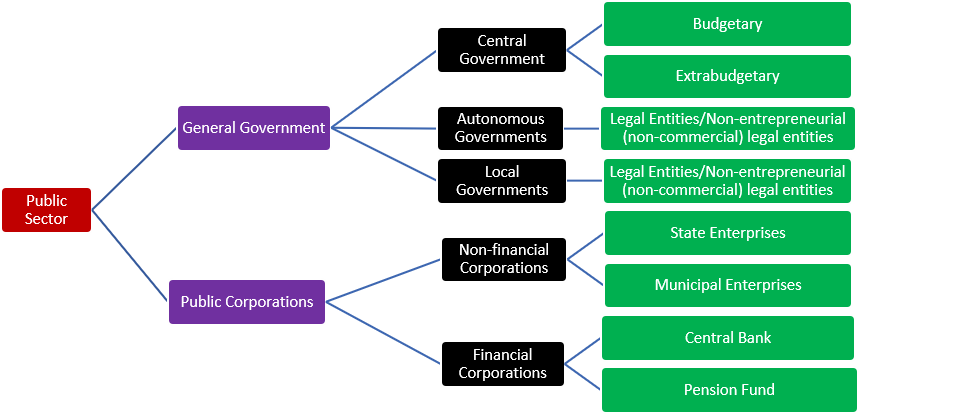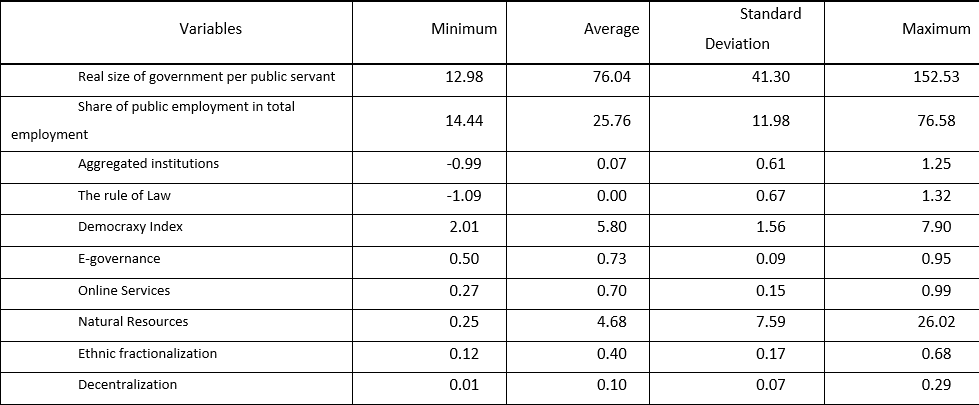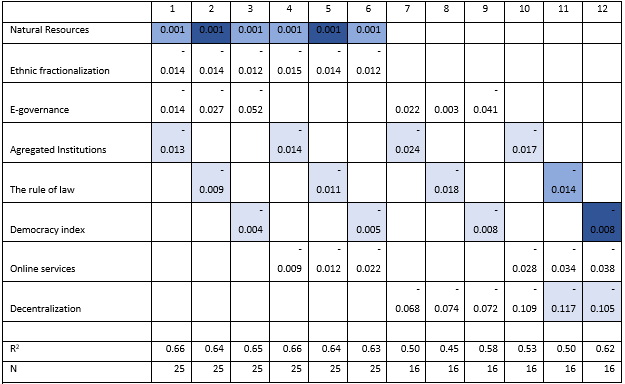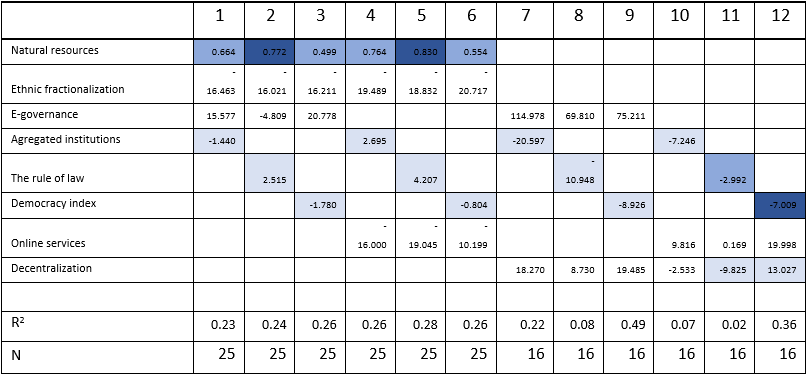Employment in Public Sector - Empirical Analysis

photo credit: Getty Images
Abstract: This paper aims to assess employment in Georgia’s public sector and study job creation factors. During the last decade, employment in the public sector has increased, and its share in total employment is, on average, 22.5%. This figure is high considering the real expenditures of the government, and the amount of delivered goods and services since some countries like Georgia ensure the provision of public services with relatively fewer human resources. On the other hand, the paper demonstrates job creation factors in the sector through regression analysis. Such a factor is politicians’ rent-seeking - creating jobs for influential groups and ensuring political stability. This is more characteristic of those countries that lack democracy and the rule of law.
Introduction
Unemployment is a long-term acute problem, and the government can reduce it in two ways: create an appropriate economic environment that will promote economic growth and employment; or become an employer itself. As a rent seeker, the government chooses the latter (Krueger, 1974) because governments are not social welfare maximizers but providers of political favours to influential groups (Olson, 1968; Becker, 1983). In the labour market, rent-seeking takes different forms. Among them is creating more profitable jobs for political power holders (Gelb et al., 1991). While job seekers hardly ever form unions to lobby for creating public sector jobs, officials still create them. Widely expressed concerns in the public drive this behaviour, and the politicians' goal is to achieve political stability. Thus, the government tends to create more jobs in the public sector.
Although an increase in public employment reduces the unemployment rate in the short term, it crowds out the private sector (Holmlund & Lindén, 1993; Malley & Moutos, 1998; Demekas & Kontolemis, 2000; Behar & Mok, 2013). Based on OECD member countries' data from 1960-2000, Algan et al. (2002) demonstrated that creating one hundred jobs in the public sector can eliminate one hundred and fifty jobs in the private sector. Besides, increased employment in the public sector can reduce the economy's productivity, as rent-seeking and rent-creating behaviour can lead to a wasteful allocation of resources (Gelb et al., 1991). In this case, resources are redistributed from the private sector to the public sector, from the highly productive sector - to the less productive sector.
This article aims to evaluate employment in the public sector in Georgia. To do so, first of all, we will define the sector's scope and analyze the level of employment from a comparative perspective. Finally, we will study employment factors in the public sector through regression analysis.
The Scope of the Public Sector
Before analyzing employment in the public sector, it is crucial to discuss its scope and structure. The public sector, as a whole, can be divided into two broad categories - state administration units and public corporations, which ensure the provision of goods and services to society and individual households, and the distribution of wealth and income (IMF, 2014). The activities of such entities are mainly based on non-market principles, and in the case of public corporations – it is on the contrary. In terms of management and control, all public sector institutional units are directly or indirectly managed by the state sector.
Scheme 1: The structure of the public sector

Units of state administration include central and subnational levels. Namely, these are all central, autonomous and municipal units and all non-profit organisations operating under their control. The central apparatus of the state - ministries, sub-departmental institutions included in the system of the ministry, legal entities of public law operating under the ministry's control, and other budgetary organisations implementing public administration belong to the state administration. The sub-national level includes the bodies of autonomous republics and municipalities, the legal entities of public and private law established by them, and other budgetary organisations. Apart from the units implementing specifically public administration-related issues, it also covers organisations included in the legislative (Parliament) and judiciary levels. The latter serves the purpose of public sector statistics production and analysis.
As for public corporations, they are divided into financial and non-financial. Financial corporations include entities involved in financial and pension fund services. These entities are National Bank, Pension Agency and other institutions providing financial services. As for the public sector's non-financial corporations, they consist of state and municipal enterprises.
Dynamics of employment in the public sector
The units discussed above create demand from the public sector to the labour market. However, their contribution to the latter is much smaller than that of the private sector. During the last decade, the public sector employed an average of 17.6% of the workforce and 22.5% of total employment. As of 2021, 316.2 thousand able-bodied people were employed in the public sector, which is an increased rate compared to previous years. For example, in 2020, the public sector employed 281.9 thousand people, which was 5.0 thousand more than in 2019. Throughout this time, employment in the public sector has increased not only in absolute terms but also in relative terms. In 2021, the public sector's share in total employment was 24.8%. This indicator amounted to 23.1% in 2018-19. During the last decade, the aforementioned index was at its lowest in 2014 - at 20.6%. Therefore, the private sector's role has decreased along with an increased share of the public sector. The latter's decline was expressed not only in relative terms but also in absolute terms. In 2021, the private sector employed 916.0 thousand of able-bodied persons. The same indicator consisted of 947.1 thousand people in 2020. It was in 2016 when the largest number of people,1,022.6 thousand people, were employed in the private sector during the last ten years.
Graph 1: Distribution of employees in Georgia by the institution (thousands)

Source: National Statistics Office of Georgia
For a broader picture of public sector employment, it is necessary to show real government spending per employee. This reflects the average supply of goods and services provided by one bureaucrat. Real government spending per employee is calculated using equation (1):
PerGW=((e^g +〖nA〗^g+〖fA〗^g) / CPI) ) / pEm (1)
The distribution of real government expenditure per employee in the public sector ( PerGW ) is equal to the ratio of the sum of current expenditure (e^g), non-financial assets (〖nA〗^g) and the growth of financial assets (〖fA〗^g) (indexed by consumer prices) ratio to the number of employees in the public sector with (pEm ).
Graph 2: Real government spending per public sector employee (2010 =100)

Source: National Statistics Office of Georgia, Ministry of Finance, Author’s calculations
In the last decade, the amount of real expenditure per employee in the public sector has increased. In this period, the increase was 64.8%. This means that relatively fewer resources are used to provide goods and services by the public sector. However, to assess the scale of employment in the public sector, it is necessary to analyse it from a comparative perspective. In particular, the size of human resources used in goods and services provided by the public sector is defined as follows:
PerGW_j=((e_j^g+〖nA〗_j^g) / 〖PPP〗_j^c)) / 〖pEm〗_j (2)
Where, in, PerGW_j, the distribution of real government expenditures per employee of the public sector of j-th countries is defined as the ratio of total real government expenditures to the number of employees in the public sector, 〖pEm〗_j. Total government expenditures are the sum of current expenditures, e_j^g and growth of non-financial assets, 〖nA〗_j^g . To make the data comparable, government expenditures are weighted by the purchasing power parity conversion index, 〖PPP〗_j^c.
Graph 3: Real Government Expenditure per Public Sector Employee (2017=100, Int. thousand)

Source: World Bank, International Monetary Fund, International Labour Organization, Author's calculations
Scandinavian countries are distinguished by a high share of the public sector in the labour market. For example, as of 2019, 30.7% of Norway's total employment is in the public sector. This indicator is 28.7% and 27.6% in Sweden and Denmark, respectively. Japan stands out with a low share rate in the public sector - 5.9%. In South Korea, this figure is 8.1% (OECD, 2021). Although the public sector's share in the Nordic countries' labour market is high, the government is very active in providing goods and services here. As a result, government spending exceeds ½ concerning the entire economy. As for South Korea and Japan, government spending is relatively small but exceeds the level of Georgia or the countries in the region. In South Korea, government spending is 38.1% of the total economy. In Japan, this figure is 47.3% (OECD, 2021). Thus, the Japanese public sector produces and delivers goods and services most efficiently, using the least resources.
As for the human resources used by the public sector in Georgia, it is helpful for a comparative analysis to consider the latter concerning transitional economies. In this direction, Slovenia and Romania occupy good positions. In these countries, for producing and delivering goods and services, the public sector uses twice as little human resources as the average of former socialist economies. The practice is similar in other EU member states, such as Poland, Estonia, Croatia, Hungary, etc. On the other hand, the Georgian public sector uses more human resources than other countries in transition on average. Compared to Georgia, other former Soviet countries employ more human resources in the public sector. For example, the public sector in Azerbaijan uses six times more human resources than the average to produce and deliver goods and services. And in Uzbekistan - four times more. Ukraine and Kyrgyzstan utilize human resources three times higher than the average among the former Soviet republics. Thus, from a comparative perspective, the public sector in Georgia employs more people than is needed to provide the given public goods and services.
Determinants of public sector employment
Let us discuss the factors of public sector employment in transitional countries. As a rule, digitization and electronic provision of public services should save resources. Among others, such resources include human capital. However, politicians are not naturally virtuous, focused on maximizing social benefits, but rent seekers. Furthermore, rent-seeking in the labour market manifests itself in creating more profitable jobs for those with political power. Thus, our research interest is the impact of public services online provision, e-governance and institutional development on public sector employment levels. The rule of law plays a leading role in institutional development. This implies a limited and balanced power of the government. Under such conditions, there is less opportunity for rentiers to create jobs in the public sector and, thus, to maintain power. The strategy for transition economies to study this empirically is based on the following equation:
PerGW_j^(-1)= α+ β_1 X_j+ β_2 Z_j+ ε (3)
Where, equation (3) is a simple regression – it’s the least squares estimation. The left side, PerGW_j , is the distribution of real government expenditures per employee in the public sector of j-th countries. On the right-hand side of equation (3), X is the vector of independent variables of our interest, and Z combines the control variables.
Table 1: Descriptive statistics of dependent and independent variables

Source: Author's calculations
To study the employment level in the transition economies' public sector, we used the inverted index of the real government expenditure per employee of 25 former socialist countries (based on 2019 data). The growth of these indicators means that a country's public sector uses more human resources to provide goods and services. Thus, this indicates that the level of public sector employment is high. In addition, UN indexes are used as variables of e-government and online services (UN, 2020), and the quality of institutions is measured by the five-year average of governance indicators (Kaufmann et al., 2011). In addition, in the institutions part, we use the democracy index, which combines the electoral process, civil rights, government functioning, political participation and political culture (Economist Intelligence, 2020).
Table 2: Dependent Variable Distribution of Real Government Expenditure per Employee, Equation 3

Source: Author's calculations
For the selection of transition countries, it is expected that the indicator of the impact of electronic and online services on public sector employment will be negative. However, this dependence is not systematic, as the coefficients estimated by equation (3) are not statistically significant. Therefore, in contrast to the institutional variables, e-government and online services are not statistically significant explanations for the variation in employment in the public sector of transitional countries. The impact of the aggregate indicator of the quality of institutions on employment in the public sector is negative (including the rule of law). Namely, the higher the degree of institutional development - political stability and accountability, limited and balanced government power – the less is the index of the goods and services produced public sector and usage of the human resources for its provision. A similar statistically significant influence is revealed in the case of democracy. There is a positive, statistically significant relationship between the democracy index and real government spending per official in transitional countries. However, such a connection's size is smaller than in the case of institutions (including the rule of law).
In addition, we used control variables in the regression analysis, which for our sample, explains most of the variation in the level of employment in the public sector. Such are natural resources. Namely, there is a statistically significant positive relationship between the average rate of natural resource rent over the last ten years (World Bank, 2022) and employment in the public sector concerning the gross domestic product. This is explained by the fact that in the case of transitional countries, natural resources are owned and managed by state companies, and employment in those organizations belongs to the public sector. For example, the highest public sector employment in the sample is in Azerbaijan, whose leading sector of the economy is the oil and gas industry. State companies represent the latter.
As Brennan and Buchanan claim (1980, p. 216), "in other equal environments, the more decentralized spending and taxation are, the less the government is involved in the economy as a whole." Not only costs and the extent of regulation but also public employment is considered here. Thus, the indicator of income decentralization is used as a control variable, the source of which is the International Monetary Fund (IMF, 2022). In this case, the expected coefficient is negative but not always statistically significant. Another control variable is ethnic fractionalization (Alesina et al., 2003). Alesina et al. (2000) demonstrated that cities with high levels of ethnic fragmentation also have high levels of public-sector employment. However, such a correlation was not found in our analysis.
We used the approach of changing a dependent variable to test the power of the above results. Namely, in equation (3), we used the inverse indicator of the real size of the government per employee as a measure of public sector employment. In this case, the dependent variable is the share of the public sector in total employment, and the analysis is based on the following equation:
Y_j= α+ β_1 X_j+ β_2 Z_j+ ε (4)
Only the left side is changed in equation (4). Namely, Y_j , is the share of the public sector in the total employment of j-th countries.
Table 3: The share of the public sector in total employment as a dependent variable, Equation 4

Source: Author's calculations
The left side of Equation (4) is the same as in Equation (3). And the share of the public sector in total employment, as a dependent variable, mostly recurs under the conditions. In this case, e-government and online services do not have a statistically significant impact, while the results mostly recurred in the case of institutions. As for democracy, according to Equation (3), it fully shares the obtained results. The case is the same for natural resources and ethnic fractionalization. The impact of natural resources on public sector employment is statistically significant and positive. As for the ethnic fragmentation, the coefficients have the expected negative signs but are statistically non-significant. Concerning decentralization, the estimates obtained by equation (4) are relatively vague and unambiguous influence is not revealed.
Conclusion
Politicians are expected to choose a path where the government is the employer rather than the private sector while fighting unemployment. This is because of the fact that they are not involved in the maximization of social welfare but in the search for rent. In this case, rent is non-monetized, political power, and the mean for influential groups to achieve job creation and ensure political stability. This kind of thing also manifests in Georgia’s public sector and reflects the latter’s employment rate. Considering total government spending, we conclude that public sector employment is high because more resources are used to provide goods and services than in transitional economies like Georgia on average. On the other hand, employment growth in the public sector has a detrimental effect on the labour market and the economy as a whole.
Thus, the public sector employment growth is a rent-seeking phenomenon by politicians. It is more characteristic of countries with low institutional development and democracy. In such conditions, political power is less limited, and the principle of balancing and restraining the government is disrupted. The latter is a favorable condition for the rent-seeking politician. This is revealed in our analysis of the determinants of public sector employment in transitional countries, as well.
For the full document, with relevant sources, links and explanations, see the attached file.


